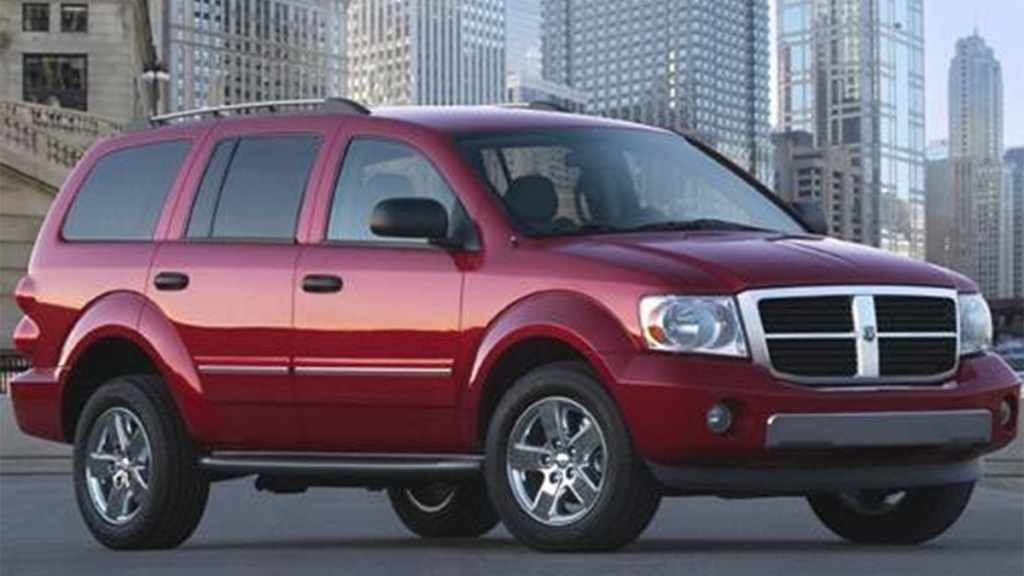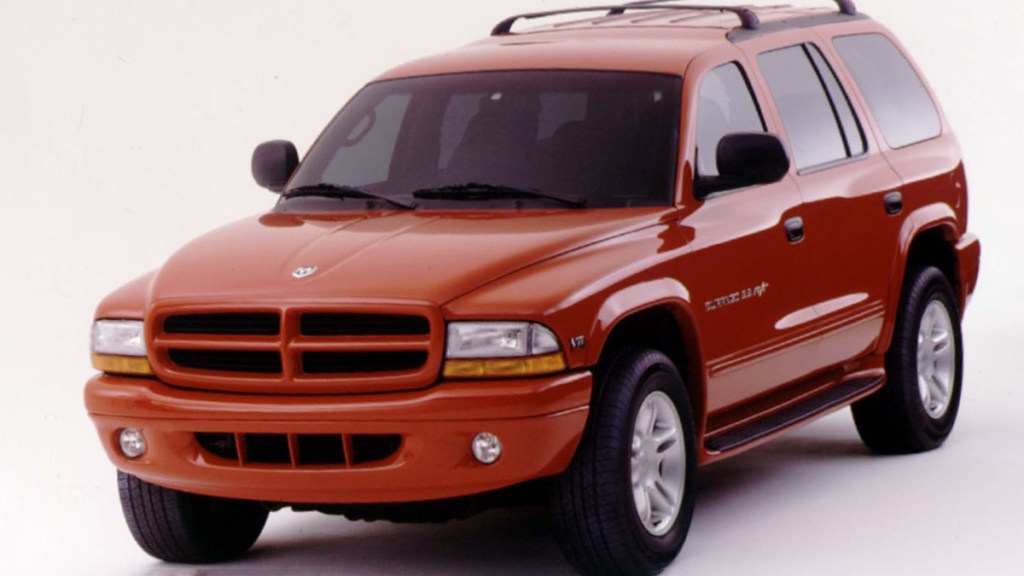Used Dodge Durango Quick Facts
- Dodge Durango model years with the best ratings for safety and reliability include 2014-2018.
- If we had a healthy budget and wanted the latest in safety tech and features, we’d opt for a 2022 or 2023 Durango.
- The Durango offers the best tow rating in its class at 8,700 pounds.
A used Dodge Durango checks a lot of boxes for a lot of different buyers. For those looking for an old-school SUV powered by its rear wheels and capable of towing heavy loads, the Durango is the king of its class. For those looking for something that turns heads and makes co-workers drool, the high-performance Dodge Durango variants have no equal. And for those looking for a roomy SUV that seats seven, offers plentiful features, and is built right here in the United States, the Durango wins again. However, if you’re looking for a modern hybrid powerplant, exceptional fuel economy, or cutting-edge design, the Durango may take a backseat to newer SUVs from Kia, Toyota, and GM.
- What Is the Best Model-Year Used Dodge Durango?
- Dodge Durango by Generation: Which Trim Should You Buy?
- Is the Dodge Durango a Good SUV?
- How Much Can the Dodge Durango Tow?
- Does the Dodge Durango Offer a Hybrid Engine?
- Can the Dodge Durango Go Off-Road?
- What Are the Most Reliable Years for the Dodge Durango?
- What Are the Least Reliable Years for the Dodge Durango?
What Is the Best Model-Year Used Dodge Durango?
- A third-generation Durango is the way to go. It dates back far enough that buying an older model with higher mileage to save money still gets you most of the features found in a new model.
- Although, if we had a healthy budget and wanted the latest in safety tech and features, we’d opt for a 2022 or 2023 Durango. These years offer the most options, trims, engines, and safety. They might have some part of their warranty in place and, thanks to the middle-of-the-road resale values, will cost thousands less than a new Durango.
- A 2014 or newer Durango is a safe bet if your budget is less generous. It gets you a better 8-speed automatic transmission and begins to add more driver-assist technology on lower trims.
See Dodge Durango SUVs for sale near you.
Dodge Durango by Generation: Which Should You Buy?
Third Generation: 2011-Current

The third-generation Durango spans many years, debuting in 2011 as an all-new model. The third-generation Durango is superior in every way compared to the previous model. It rides on a shared platform with the Jeep Grand Cherokee, helping improve ride quality, reduce cabin noise, and provide a more rugged frame for towing and off-road adventuring. The Durango’s tech arsenal is far ahead of most competitors of the time, offering things like adaptive cruise control even as far back as 2011.
The Durango line initially includes four trims: SXT, Crew, R/T, and Citadel. As the years pass, the lineup expands to include the Limited, GT, SRT, and the irrationally overpowered Hellcat.
The standard engine on most trims is the proven 3.6-liter Pentastar V6. With between 290 and 295 horsepower, depending on year and model, the V6 is more than adequate to pull a loaded Durango around. It has a better fuel economy than the V8s, yet it can still tow up to 6,200 pounds. The V8 option brings several choices including a 360-hp 5.7-liter V8, a 475-hp 6.4-liter V8, and a 710-hp supercharged 6.2-liter V8.
The Durango may not be the newest 3-row SUV, but it is well-equipped. Dating back to 2011, it offers options like adaptive cruise control, a feature that didn’t appear on most competitors until around 2015.
The base Durango is not fancy, but once you move to the GT and higher trims, the Durango takes on a decidedly sporty feel. Think of it as a 3-row Dodge Charger. V6 trims offer options like automatic climate control, power front seats, second-row captain’s chairs, heated rear seats, rain-sensing wipers, and high-end audio options from companies like Alpine and Harman Kardon. All-wheel drive (AWD) is optional on all but some high-performance models, where it’s standard. A beefed-up tow package elevates the V8-powered Durango’s towing from 7,400 pounds to 8,700 pounds.
Driver assists include forward collision warning and braking, automatic high beams, adaptive cruise control, a blind-spot monitor, rear cross-traffic detection, and lane-keeping assist.
Moving up the trim ladder brings more choices, such as a heated steering wheel, a power liftgate, navigation, a 10.1-inch touchscreen, a wireless charging pad, a power tilt/telescoping steering wheel, a self-leveling rear suspension, and driver’s seat memory.
The R/T offers a performance package that adds Brembo brakes, an adaptive suspension, SRT performance-tuned steering, and 20-inch wheels.
The SRT 392 and Hellcat trims move the Durango into BMW and Audi territory, at least as far as performance goes.
Model-Year Changes
2025: The 6.4-liter V8 is discontinued.
2024: Blind-spot monitoring made standard.
2023: The Hellcat returns, and heated front seats become standard.
2022: The Hellcat trim is discontinued, while the base model gains more safety tech. The SXT acquires standard 3-row seating and rear parking sensors, while the GT gets remote start, a power liftgate, and a heated steering wheel.
2021: The 710-hp Hellcat arrives, and new upgrades include wireless smartphone integration, an upgraded tow package, and a wireless charging pad.
2020: No major changes.
2019: Most changes are cosmetic, with some new options, such as a 19-speaker Harman Kardon audio system, an integrated trailer brake, and captain’s chair seating, made standard on Citadel.
2018: The SRT trim debuts with standard all-wheel drive, a 475-hp V8, and an 8,700-pound tow rating. Apple CarPlay and Android Auto debut.
2017: The Limited trim joins the lineup.
2016: Models with the V6 get start/stop technology.
2015: Beats Audio by Dr. Dre became standard on the R/T and optional on Citadel and Limited.
2014: Revised styling and a new 8-speed automatic highlight the changes.
2013: New options include heating and cooling front seats.
2012: The Express trim becomes the SXT.
See 2011-to-current Dodge Durango SUVs for sale near you.
Second Generation: 2004-2009

The second-generation Durango improves on the original, employing a fully boxed frame and 3-row seating for eight. Longer, wider, and more powerful, the second-gen Dodge Durango offers more safety features and better ride and handling. Engine options include a 3.7-liter V6, 4.7-liter V8, and 5.7-liter V8. In 2009, a mild-hybrid option debuted. Regrettably, this model ceased production after only a few months due to the Great Recession.
The second-generation Durango has a good record for owner satisfaction and safety, so it’s a good choice for those on a really tight budget. However, due to its age, finding a low-mileage Durango in good condition may prove quite challenging.
See 2004-2009 Dodge Durango SUVs for sale near you.
First Generation: 1998-2003

The original Durango shares its platform with the Dodge Dakota pickup, copying its front end, dash, and interior. Seating for seven and a 7,500-pound tow rating allow the Durango to tread on some full-size SUV turf.
Engine choices include a 3.9-liter V6, 4.7-liter V8, 5.2-liter V8, and 5.9-liter V8.
See 1998-2003 Dodge Durango SUVs for sale near you.
Is the Dodge Durango a Good SUV?
The third-generation Durango has average reliability and resale scores. The V6 is surprisingly strong and can tow a great deal of weight. V8 models offer more power and towing ability but may cost more to operate. A well-maintained late-model Durango will cost less than an equivalent Honda Pilot or Toyota Highlander, which makes it an attractive, used SUV candidate.
How Much Can the Dodge Durango Tow?
The third generation is tow-rated up to 8,700 pounds, but most V8s with all-wheel drive are rated at 7,400 pounds, and the V6 models top out at around 6,200 pounds. The second-generation Durango elevates the rating to 7,400 pounds, while the first-gen stops at 5,900 pounds.
Does the Dodge Durango Offer a Hybrid Engine?
For a few months in 2009, Dodge offered a mild-hybrid option that added two small electric motors to the 5.7-liter V8. The short-lived hybrid featured standard all-wheel drive, 400-hp output, and about a 5-mpg improvement in city fuel economy over the non-hybrid Durango.
Can the Dodge Durango Go Off-Road?
The Durango is capable of off-roading, with a sturdy chassis, good ground clearance, and available all-wheel drive. Newer models include a terrain management system with sand, mud, snow, rock crawl, and mud settings.
What Are the Most Reliable Years for the Dodge Durango?
The third-generation Durango is the best for reliability. Specific model years with the best ratings for safety and reliability include 2014-2018 and 2022-2024.
What Are the Least Reliable Years for the Dodge Durango?
In general, we’d avoid the first- and second-generation Durango and any model with exceptionally high mileage greater than 150,000 miles.











